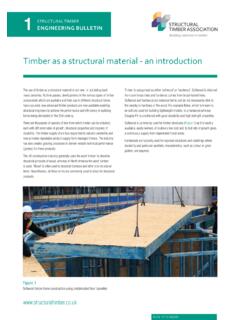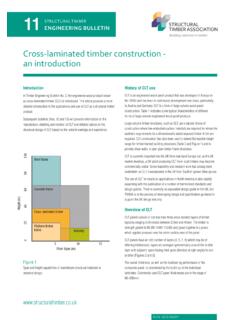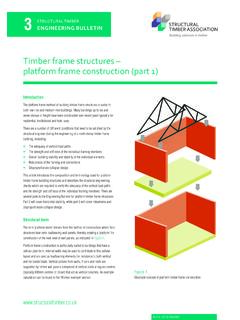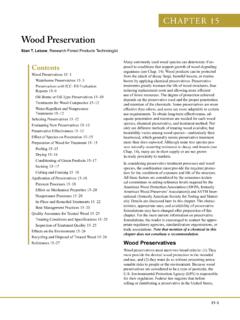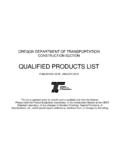Transcription of Glued laminated timber structures - Structural Timber
1 8 Structural Timber . ENGINEERING BULLETIN. Glued laminated Timber structures Figure 1. Glulam in a commercial building Introduction Timber and engineered wood products can be used as the primary material for many forms of structures . While taking advantage of sustainability credentials as a carbon neutral and renewable resource, the engineered wood products are also often selected to be exposed for aesthetic reasons. One of the most versatile engineered wood product materials is Glued laminated Timber or glulam' (Figure 1). Other engineered wood products (EWPs) such as laminated veneer lumber and standard sawn Timber products can also be used in place of glulam, taking account of the particular characteristics of that material type.
2 For more information on the range of EWPs available reference should be made to Timber Engineering Bulletin No. 21. This Engineering Bulletin ( ) introduces the engineering principles of some common frame types and describes, in more detail, the glulam material and specification. Figure 2. Hybrid braced post and beam structure concepts for multiple storey The technology to remove original wood strength reducing characteristics ( knots) and bond small thicknesses of Timber together to form a Structural member of significant depth and width, has been used commercially since This Engineering Bulletin provides a review of glulam in two of the most the 1950s.
3 Glulam manufacturing plants are sophisticated production lines common Structural forms: post and beam' and two dimensional rigid frames. producing quality assured products to enable reliable performance to be achieved for engineered Timber structures . REV 0 - 8 Structural Timber . ENGINEERING BULLETIN. Post and beam forms of construction tend to use columns and beams joined Glued laminated Timber (Glulam). together with nominally pinned connections using steel plates and metal Glulam is an engineered wood product, manufactured from layers of parallel fasteners.
4 It is possible to build structures of a number of storeys by Timber laminations (normally spruce or pine but occasionally more durable providing braced bays for stability and steel connection shoes at each floor Timber species such as larch, Douglas fir or even hardwoods such as oak or level, to provide ease of connectivity and to ensure durability of the Timber sweet chestnut). components (Figure 2). Horizontal actions are resisted by the diagonal bracing members resulting in relatively stiff frames. Pieces of sawn Timber are graded for strength, before being Glued together under pressure with the grain in the laminates running parallel to the Two dimensional rigid frames are typically used for single storey structures longitudinal axis of the section.
5 Strength-reducing defects such as knots, where stability bracing is not appropriate and rigid' moment-resisting splits and sloping grain are randomly distributed throughout the component connections are used between members to create frames which are resistant allowing glulam to be designed to higher stresses than solid Timber of the to horizontal actions but which will exhibit some sway defl ection depending same grade. on the stiffness of the frame. It is also possible to extend rigid frames to two or three storey structures . In these situations, however, the overall sway of Individual laminates can be end-jointed by the process of fingerjointing the frame needs to be carefully considered.
6 Figure 3 indicates a number of to produce long lengths in accordance with the requirements of BS EN. commonly used rigid frames. 385:20013. One of the greatest advantages of glulam is that it can be manufactured in a wide variety of shapes, sizes and configurations. In most The fire resistance of glulam and other Timber materials in service has been cases horizontal glulam (Figure 4a) is used. Beams wider than the normally published in a previous Engineering Bulletin No 7. available laminate widths can be manufactured by laying boards of diff erent Other Bulletins investigate the construction and connection details widths side by side and reversing each layer so that there is an overlap and appropriate to low rise glulam frame construction in more detail.
7 No straight through vertical joint (Figure 4b). Where a tighter radius curve on plan is required, glulam with the laminates arranged vertically is used to Figure 3 enable curving of the section (Figure 4c). Two dimensional rigid frames such as propped portals, portal frames and arch Structural forms In addition to straight prismatic sections, beams can also be single tapered, double tapered and bevelled. Curved profiles range from a simple curved beam to a pitched and tapered curved beam, to a complex arch configuration. Curved glulam (Figures 5 and 6) is manufactured by bending laminates on formers before being bonded together with adhesive, clamped and cured.
8 In this way, even three dimensional curves can be produced. However these are expensive and often result in signifi cant locked-in stresses in the members which must be taken into account in the design. The requirements for the manufacture of glulam are contained in product standard BS EN 14080:20054 and glulam complying with this standard must Figure 4 be specifi ed and delivered as CE marked. (Note that BS EN 14080: 2005 is (a) horizontal glulam (b) wide beams made from soon to be replaced with BS EN 14080: 2013 which will supersede BS EN. horizontal glulam (c) glulam with laminates arranged vertically 385, 386, 387, 390, 391, 392, 1194 and 14080:2005).
9 Figure 5. Horizontally laminated , curved glulam Figure 6. Vertically laminated , curved on plan glulam REV 0 - 2. 8 Structural Timber . ENGINEERING BULLETIN. Table 1: Size limitations on glulam Glulam sizes and availability conditions are applicable (for defi nitions of service classes refer to Engineering Bulletin No. 1. The most common Timber species used for SC1. Glulam manufacturers tend to offer a range of standard sizes based on conditions is European whitewood (typically Norway spruce and fir) as multiples of a lamination thickness for the depth and a fairly small range of defined in BS EN 13556:20039 which bonds and machines well, provides widths.)
10 Depths in the range 180-630mm and widths in the range 66-200mm a clean bright surface and has an excellent strength to weight and stiffness are common. The most frequently used sizes will be available from stock or to weight ratio. Whitewood glulam complying with the forest certifi cation on a short order time, whereas bespoke sizes and shapes will require a longer schemes of FSC and PEFC is readily available. lead time. Laminations are typically 33mm or 45mm thick but smaller laminations Glulam for unheated internal environments or occasional may be required where tightly curved or vertically laminated sections are exposure (SC2).
